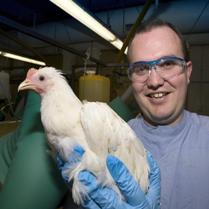New discovery, scientists take fresh look at poultry disease

Poultry scientists are taking a fresh look at the devastating poultry bacterial disease, necrotic enteritis, following a world-first discovery.
The discovery was made by a Monash University PhD student working at CSIRO’s Australian Animal Health Laboratory (AAHL) in Geelong.
In a paper published on 8 February in the respected ‘open access’ international journal PLoS Pathogens , Anthony Keyburn and a team of Australian scientists outline the discovery of a new toxin and the finding that alpha-toxin protein – long thought to be required for necrotic enteritis to develop – is not the main cause of the chicken disease.
Poultry industry has suffered huge losses
Necrotic enteritis is one of the world’s most common and financially crippling poultry diseases, costing the world’s poultry industries an estimated US$2 bln every year, says Keyburn, who has been working at AAHL on an Australian Poultry Cooperative Research Centre (CRC) project.
“It’s caused by Clostridium perfringens , a bacterium found in soil, litter, dust and in small quantities in the intestines of healthy chickens. The bacterium only causes disease when it proliferates to high numbers, producing extracellular toxins that attack the bird’s intestines, causing lesions,†he explained. Poultry producers use antibiotics to treat and prevent the disease, which, when triggered, can cause mortality rates of up to 50%.
Alpha-toxin not the key
The disease was first described in 1961 when alpha-toxin was implicated as the major causative factor. However, definitive proof has never been reported. This resulted in all vaccine development work for the last 30 years been based on the assumption that alpha-toxin was the key.
The research team at AAHL began to question the involvement of alpha-toxin when a survey showed that local disease-causing bacterial strains produced low levels of this toxin. “We tested the importance of alpha-toxin by genetically altering the bacterium so it no longer produced any of the protein,†said Keyburn. “Despite the toxin’s absence, our bacterial isolates still caused disease in chickens. This demonstrates that the development of necrotic enteritis in chickens is not dependent on C. perfringens producing a functional alpha-toxin.â€
The real cause of necrotic enteritis
This finding led the team to expand their search for the real cause of necrotic enteritis, finding a novel toxin – NetB – that is involved in the disease-causing potential of a high proportion of virulent C. perfringens strains.
These discoveries have led to a new research project being established within the Australian Poultry CRC led by CSIRO’s Dr Rob Moore and Monash University’s Professor Julian Rood – a Chief Investigator with the Australian Research Council Centre of Excellence in Structural and Functional Microbial Genomics. The project is investigating NetB and other proteins produced by C. perfringens, with the aim of developing effective vaccines against the disease.
Develop a vaccine soon
“Around the world, poultry producers are waiting for vaccines against necrotic enteritis,†said Dr Moore. “Thanks to Anthony’s discoveries, scientists should now be able to develop the vaccines within a couple of years.â€
In the picture (by Frank Filippi, CSIRO): Poultry disease researcher, Anthony Keyburn.
Source: CSIRO
Related links:
– CSIRO
– Australian Research Council Centre of Excellence in Structural and Functional Microbial Genomics













